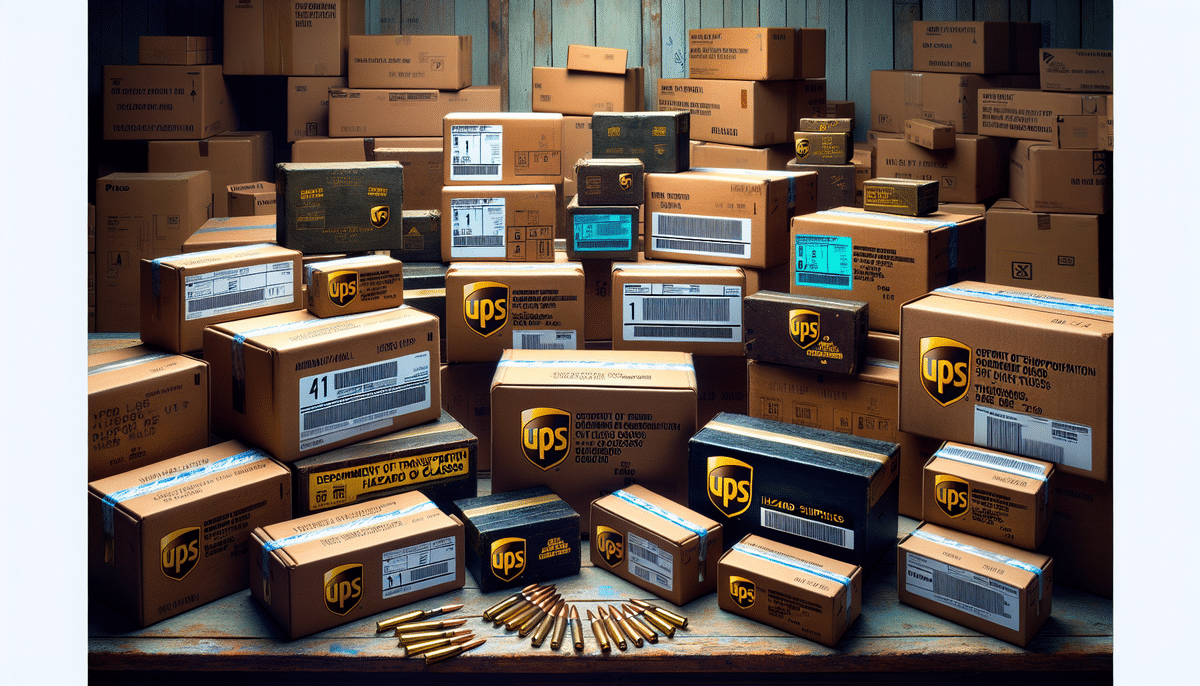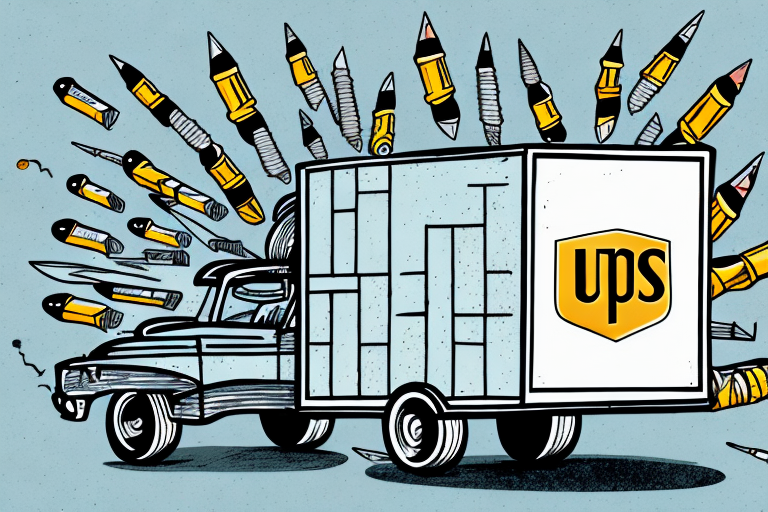Understanding UPS Shipping Rates for Ammunition
Shipping ammunition involves navigating complex regulations and adhering to strict guidelines to ensure the safe and legal transport of these hazardous materials. Understanding how shipping rates for ammunition are calculated by carriers like UPS is crucial for compliance and cost management. This article delves into the various types of ammunition, their specific shipping requirements, and the factors influencing UPS shipping rates. Additionally, we provide actionable tips for reducing shipping costs, proper packaging procedures, and guidance on tracking shipments and filing claims for lost or damaged items.
Overview of Ammunition Shipping
Ammunition, categorized under hazardous materials, requires meticulous handling and compliance with both domestic and international regulations. The shipping delays associated with ammunition underline the importance of understanding shipping processes and carrier policies.
Why Shipping Ammunition Is Regulated
The shipment of ammunition is governed by stringent regulations due to the inherent safety risks associated with transporting hazardous materials. The U.S. Department of Transportation (DOT) enforces specific guidelines, including labeling, documentation, and packaging standards, to mitigate these risks throughout the supply chain.
International shipments of ammunition are subject to additional oversight by organizations such as the International Air Transport Association (IATA) and the International Maritime Organization (IMO). Compliance with these international standards is critical to avoid penalties, legal repercussions, and potential loss of shipping licenses.
The classification of ammunition—whether standard, explosive, or incendiary—affects the regulatory requirements. For instance, shipments containing explosive or incendiary rounds may necessitate extra permits and approvals from relevant government agencies, ensuring that all transportation adheres to safety protocols.
The Different Types of Ammunition and Their Shipping Requirements
Ammunition types vary in their shipping classifications and requirements. For example:
- Small Arms Ammunition: Typically classified under ORM-D (Other Regulated Materials-DOT) for domestic ground transportation, requiring specific packaging and labeling.
- Explosive Ammunition: Requires specialized packaging and handling procedures, often necessitating additional permits and restricted shipping methods.
- Incendiary or Tracer Rounds: Often prohibited from air transport and may require separate shipping channels or permits.
Non-compliance with these regulations can lead to shipping delays and substantial penalties. Moreover, appropriate storage conditions—such as maintaining a cool, dry environment away from unauthorized access—are essential to ensure the integrity and safety of ammunition during storage and transport.
When shipping internationally, it's imperative to research and comply with the destination country's laws regarding ammunition importation to prevent legal complications.
How UPS Calculates Shipping Rates for Ammunition
UPS determines shipping rates for ammunition based on several key factors:
- Weight and Dimensions: The heavier and larger the package, the higher the shipping cost.
- Origin and Destination: The distance between the two ZIP codes affects the rate, with longer distances typically costing more.
- Service Level: Options like next-day delivery are more expensive compared to ground or standard shipping services.
- Special Handling and Surcharges: Ammunition is considered a hazardous material, which may incur additional fees for compliance with safety standards.
- Mode of Transportation: Air freight tends to be more costly than ground due to stricter regulations and security measures.
- Seasonal Demand: Rates may fluctuate during peak shipping seasons, such as the holiday period, due to increased demand.
Moreover, the type of ammunition being shipped—standard vs. explosive—can influence the rate due to varying safety and packaging requirements.
For comprehensive rate calculations, UPS recommends using their shipping calculator, which accounts for all relevant factors to provide an accurate estimate.
Factors That Affect UPS Shipping Rates for Ammunition
Beyond the primary calculations, several additional factors can influence the cost of shipping ammunition with UPS:
- Insurance and Coverage: Opting for higher insurance coverage can increase the total shipping cost.
- Fuel Surcharges: Fluctuations in fuel prices can lead to variable surcharges.
- Bulk Shipments: Larger or multiple shipments may benefit from volume discounts, reducing the per-unit shipping cost.
- Packaging Requirements: Specialized packaging to meet DOT regulations can add to the overall expense.
Compliance with UPS and DOT regulations is non-negotiable. Non-compliance can result in additional fees or legal consequences, emphasizing the need for thorough understanding and adherence to shipping guidelines.
Tips for Reducing UPS Shipping Costs for Ammunition
To minimize shipping costs when handling ammunition with UPS, consider the following strategies:
- Consolidate Shipments: Combining multiple orders into a single package can reduce overall shipping expenses.
- Choose Appropriate Service Levels: Selecting slower delivery options can lower costs if expedited shipping is not necessary.
- Optimize Packaging: Using the most efficient packaging can decrease weight and dimensional weight, leading to cost savings.
- Leverage Discounts and Promotions: UPS offers discounts for frequent users or bulk shipments. Explore available promotions to reduce costs.
- Compare Alternative Carriers: Evaluate rates from other shipping providers like FedEx or USPS to find the most cost-effective option for your needs.
Utilizing a UPS shipping calculator or consulting with a UPS representative can also help identify additional cost-saving opportunities.
The Importance of Proper Packaging When Shipping Ammunition with UPS
Effective packaging is critical to the safe shipping of ammunition. Key considerations include:
- Material Selection: Use sturdy cardboard boxes with sufficient cushioning for small arms ammunition. For larger or explosive types, heavy-duty plastic containers or foam padding may be required.
- Compliance with DOT Regulations: Ensure all packaging meets DOT standards to prevent damage and avoid surcharges or penalties.
- Labeling: Accurate and visible labeling is essential for hazardous materials to inform handlers and comply with regulations.
Proper packaging not only ensures the safety of the ammunition during transport but also helps in maintaining compliance with UPS's regulatory requirements, avoiding unnecessary fees and delays.
How to Track Your UPS Ammunition Shipment
Monitoring the status of your UPS ammunition shipments is straightforward and can be done via:
- Tracking Number: Upon shipment, UPS provides a tracking number that can be used to monitor your package’s progress in real-time through the UPS website or mobile app.
- Delivery Notifications: Opt into delivery alerts to receive updates on the estimated delivery time, delayed shipments, or any issues encountered during transit.
Effective tracking allows for better coordination of delivery times and proactive management in case any issues arise during transportation.
Common Mistakes to Avoid When Shipping Ammunition with UPS
To prevent incurring additional fees or penalties when shipping ammunition with UPS, avoid the following common mistakes:
- Incomplete Documentation: Ensure all necessary paperwork, such as permits and shipping manifests, are accurately completed and included.
- Improper Labeling and Packaging: Use correct labels and adhere to packaging guidelines to comply with regulations.
- Shipping Prohibited Materials: Verify that the type of ammunition being shipped is allowed under UPS and DOT regulations to avoid legal repercussions.
Collaborating with experienced shipping partners like UPS can help identify and rectify potential issues before they escalate.
How to File a Claim If Your UPS Ammunition Shipment Is Lost or Damaged
In the unfortunate event that your UPS ammunition shipment is lost or damaged, you can file a claim to seek reimbursement. Follow these steps:
- Document the Damage: Take clear photos and provide a detailed description of any visible damage to the shipment.
- Gather Proof of Value: Include receipts or invoices that demonstrate the value of the lost or damaged items.
- Contact UPS: Reach out to UPS customer service to initiate the claims process, which typically involves submitting a claim form along with the required documentation.
Engaging with a shipping partner that offers comprehensive insurance options and assistance with the claims process can facilitate a smoother resolution.
Recent Changes in UPS Policies Regarding the Shipment of Ammunition
As of 2023, UPS has updated its policies concerning ammunition shipments to align with new DOT regulations and evolving industry standards. Key changes include:
- Enhanced Packaging Requirements: Stricter guidelines on the materials and methods used for packaging ammunition to ensure higher safety during transit.
- Service Level Adjustments: Revision of available service options for different ammunition types, potentially affecting delivery times and costs.
- Additional Documentation: Increased emphasis on accurate and comprehensive documentation to streamline the shipping process and reduce delays.
Customers must familiarize themselves with these updated policies to maintain compliance and ensure the smooth shipment of ammunition via UPS.
Alternatives to UPS for Shipping Ammunition
While UPS is a leading choice for shipping ammunition, other options may better suit specific needs:
- Specialized Shipping Providers: Companies that specialize in hazardous materials shipping offer expert handling and may provide more tailored services for ammunition.
- State-Specific Ground Freight: Some states permit in-state ammunition shipments using ground freight, which can be cost-effective for local deliveries.
- FedEx and USPS: Alternative carriers that also offer ammunition shipping services, each with their own sets of regulations and pricing structures.
Evaluating multiple carriers and understanding their unique policies can help determine the most suitable and cost-effective option for ammunition shipments.
Frequently Asked Questions about Shipping Ammunition with UPS
Q: Can I ship ammunition through USPS?
A: USPS has specific restrictions and limitations regarding ammunition shipments. It's advisable to consult USPS guidelines closely and consider partnering with a carrier like UPS that specializes in hazardous material shipping to ensure compliance with all safety and regulatory requirements.
Q: Can I ship ammunition internationally?
A: International shipping of ammunition is complex due to varying regulations and restrictions on hazardous materials across countries. Collaborating with an experienced international shipping provider like UPS ensures adherence to all applicable requirements and regulations.
Q: What type of packaging is required for shipping ammunition?
A: Packaging requirements differ based on the ammunition type. Compliance with DOT regulations is essential, which may involve using specific materials like sturdy cardboard boxes for small arms ammunition or heavy-duty plastic containers for explosives. Proper labeling and cushioning are also critical components of compliant packaging.
Q: How can I reduce the cost of shipping ammunition with UPS?
A: Cost-reduction strategies include consolidating shipments, selecting appropriate service levels, optimizing packaging to reduce weight and size, leveraging available discounts, and comparing rates with alternative carriers. Utilizing a shipping calculator or consulting with a UPS representative can uncover further savings opportunities.
Conclusion
Shipping ammunition with UPS necessitates a thorough understanding of applicable regulations, meticulous adherence to packaging and documentation standards, and strategic cost-management practices. By comprehensively grasping how UPS calculates shipping rates for ammunition and considering the various factors that impact these rates, customers can make informed decisions that optimize both compliance and cost-efficiency. Proper packaging, diligent tracking, and proactive handling of potential issues are essential steps in ensuring the safe and legal transport of ammunition. Collaborating with experienced shipping partners like UPS provides valuable support and expertise, facilitating a seamless shipping process.






















